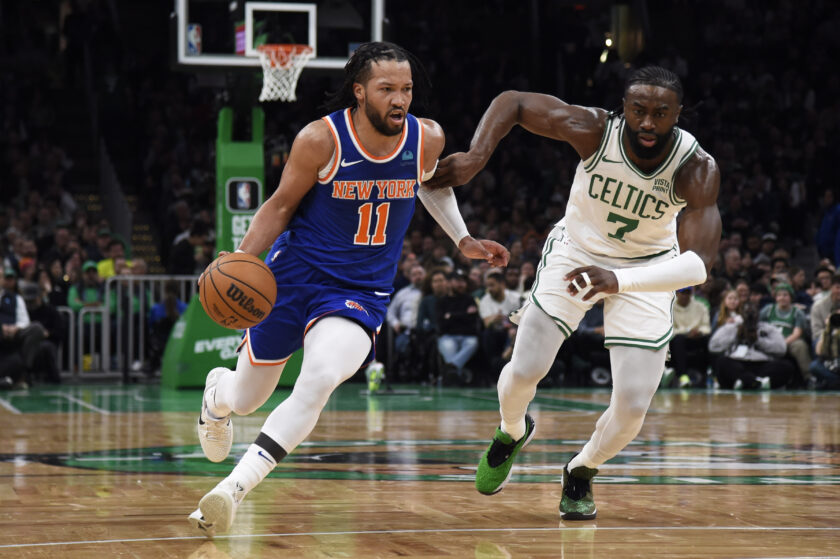NBA Mock Draft 2022: Paolo Banchero, Chet Holmgren or Jabari Smith at No. 1?

The 2022 NBA Draft is almost here and there is a clear-cut group at the top.
Jabari Smith Jr., Paolo Banchero, Chet Holmgren and Jaden Ivey are the top four picks here. Obviously, there is going to be some movement as the draft approaches. Here’s a quick look at what my board looks like.
1. Houston Rockets: Jabari Smith Jr., F, Auburn (2003)
Smith is the real deal. If there is an ideal NBA body type, it’s his. He’s long and athletic enough to cover any position on the floor, which means he’s going to make an immediate impact on defense.
“Defensively, this kid has a lot of potential switching one through five and being able to disrupt anything on the ball and off the ball,” Auburn video coordinator Ian Borders said on ESNY’s Knicks State of Mind podcast. “He is your prototypical NBA — I hate to say big man — we call them big guards at Auburn.”
Smith’s defense and three-point prowess (42% on 5.5 attempts per game) will allow him to make a high-level impact from the get-go. Whether or not he can add some polish to his offensive game is going to determine his overall ceiling. If Smith can start to finish through contact and add to his offensive skill set, he will be a bonafide superstar.
Houston having the top pick shouldn’t make much of a difference here. Smith would be a perfect fit on 30 of 30 NBA rosters.
2. Indiana Pacers: Paolo Banchero, F, Duke (2002)
Banchero is the most NBA-ready scorer in this class. New Yorkers may have already heard the comparisons to Carmelo Anthony for his willingness — check that, his desire to operate out of the mid-post iso.
His 6-foot-10 frame means he can go over smaller defenders. On the flip side, if teams counter with bigger, stronger defenders, he has the offensive skillset and physicality to win those matchups. Banchero’s offensive skillset is the reason why he has been consistently mocked as a top-three pick throughout this draft process.
The defense is a bigger question mark, but he has the size, athleticism, and toughness to become a tough matchup on that end of the floor. His instincts and length as a help defender are intriguing. The defense is something to work on, but it shouldn’t be a huge concern.
With Domantas Sabonis out of Indiana, Banchero seems like a great fit at the four spot going forward.
3. Orlando Magic: Chet Holmgren, F/C, Gonzaga (2002)
Holmgren is another player who has been at the top of draft boards since the creation of 2022 draft boards. Although his skinny frame is a concern, his unique skillset overwhelms any of those concerns. I promise this will be my one “unicorn” reference of this mock draft, but Holmgren is deserving of the moniker.
Eventually, he will need to play most of the minutes at the five to maximize his value, but Holmgren will slot in nicely as a power forward to start. His versatile offensive package means he’s more than capable of thriving at that spot. After all, we already saw him average 3.7 blocks per game alongside Drew Timme at Gonzaga.
And since he won’t be matched up on centers, he will have more opportunities to roam as a help defender rather than a back-to-the-basket rim protector. A frontcourt pairing of Holmgren and Wendell Carter Jr. will bring some Magic back to Orlando.
4. Detroit Pistons: Jaden Ivey, SG, Purdue (2002)
This fit for Ivey in Detroit feels like a winner. I would put Ivey into the category of “combo guard” or “lead guard” instead of a true one or two. Cade Cunningham can be the pure point guard who distributes to his teammates and initiates the halfcourt offense.
Meanwhile, Ivey can be a downhill menace who pushes the pace in transition. He’s going to be useful in the halfcourt as well. His ability to operate out of the pick-and-roll will end up being his best halfcourt skill at the next level. Again, it’s his ability to get downhill that will be his best asset.
He still needs to find his rhythm at times on the court. Knowing when to put the pedal on the accelerator and when to dial it back is going to be key to his development.
5. Oklahoma City Thunder: AJ Griffin, F, Duke (2003)
Griffin’s draft stock has been a rollercoaster ride to this point. He was a highly-touted recruit out of high school who was seen as a definitive one-and-done player. But a slow start and disappointing numbers started to leave doubt about his status as a top draft prospect.
In fact, a mock draft I put together back in December had Griffin dropping to 13, which was pretty high compared to some of the other outlets at that point in time. However, a strong finish to the season — marked by a 44.7% three-point clip — is putting Griffin back at the top of draft boards, rightfully so.
The Oklahoma City Thunder have a million draft picks over the next few years. They might as well take the best player available. That player just so happens to be a young wing oozing with talent — right in Sam Presti’s wheelhouse.
6. Portland Trail Blazers: Jalen Duren, C, Memphis (2003)
Plain and simple, Duren is the best rim-running center in this class. He can go from a block on one end to a dunk on the other in the blink of an eye. Although Memphis struggled at times during their season, Duren’s potential shined through the entire time.
While he’s not going to be a floor-spacer or a great passer from day one, his rim-running abilities are already there. He needs to keep adding to his offensive game to develop into a legitimate star, but he should hit the ground running as a capable center.
Portland could be looking for a new center depending on how negotiations go with Jusuf Nurkic. Duren could be a change of pace in the pick-and-roll pairing with Damian Lillard going forward.
7. Sacramento Kings: Bennedict Mathurin, SG, Arizona (2002)
Let Sacramento take the best wing available and throw him out there with De’Aaron Fox, Domantas Sabonis, and Davion Mitchell. Mathurin drew attention early in the season with his three-level scoring prowess and splashy defensive plays.
Mathurin can shoot it on the catch or off the bounce from basically anywhere on the floor. He is a dynamic threat in transition and punishes wild closeouts. With other offensive talents around him, Mathurin should thrive as a third or fourth option to start.
Defensively, he can guard guards and wings. He might have trouble with bigs at the next level, but he won’t be overmatched on defense. If nothing else, the Kings will be fun to watch.
8. New Orleans Pelicans (via Los Angeles Lakers): Dyson Daniels, G, Ignite (2003)
Daniels is the first G League player off the board in 2022. The 6-foot-8 combo guard brings everything to the table — length, athleticism, poise with the ball, and a strong feel for the game.
While he’s not a pure point guard, we would argue that there aren’t many pure point guards left in the NBA. The league is transitioning towards combo guards and lead guards, a role that Daniels fills. The shooting splits could be better .500/.333/.400, but his potential as a playmaker overshadows any shooting concerns.
New Orleans seems like a safe landing spot for Daniels. He will be surrounded by guys who can handle the ball — CJ McCollum, Brandon Ingram, Zion Williamson — as he develops.
9. San Antonio Spurs: Keegan Murray, F, Iowa (2000)
Murray is the first player born before 2002 in the lottery and only one of three such players. If you are wondering why he’s going as a top-10 pick, look no further than his high-level production at Iowa. He’s a tweener forward who can score the rock in just about every way you could imagine.
For the Spurs, Murray can add another layer to the frontcourt as a dynamic scorer off the bench with the potential to grow into a bigger role.
10. Washington Wizards: Johnny Davis, G, Wisconsin (2002)
While Davis doesn’t fit into that pure point guard category, he is a ballhandler who can create off the dribble. The Wizards need another guard who can help Bradley Beal with the ballhandling duties. Davis fits that mold and he’s the best available guard at this point in the draft.
Although his 30.6% three-point shooting clip from last season is a bit of a concern, he was tasked with taking tough shots on a Wisconsin team that needed him to be the guy. Expect a more manageable shot profile at the next level. In other words, when the shot clock is running down, he won’t always need to be the one to pull a rabbit out of his hat.
11. New York Knicks: Shaedon Sharpe, G, Kentucky (2003)
Sharpe is the biggest mystery in the draft given the fact that he didn’t play a single game for Kentucky this year. Once thought as a potential top-five pick, Sharpe will fall a bit, but his sheer talent will keep him in the lottery.
Despite his lack of experience, Sharpe has all the physical tools to be an NBA player. He’s more of a wing than a ballhandler, but he could develop into a guy the Knicks rely on to create his own shot.
Do we even have to discuss the Kentucky-Knicks connection at this point? Sure, Kenny Payne is off to Louisville, but we don’t expect this Kentucky-Knicks pipeline to dry up anytime soon. After all, Leon Rose and Worldwide Wes are still running the show in MSG.
12. Oklahoma City Thunder (via Los Angeles Clippers): Tari Eason, F, LSU (2001)
The 3-and-D archetype applies to Eason as much as anyone. The “3” part of his game is still coming along, but the “D” part of his game is in good shape. His defensive versatility is the type to make NBA front offices drool.
Again, the Thunder are stockpiling young talent and no NBA team can have too many wings. Eason’s overall development on the offensive end is going to determine his ceiling, but his defense should turn him into a useful player off the bench at the absolute minimum. OKC can add to its treasure chest of young players.
13. Charlotte Hornets: Ochai Agbaji, F, Kansas (2000)
Charlotte has two of the next three picks, but they are starting with Agbaji. The NCAA Tournament’s Most Outstanding Player is coming in from a winning program to a team that is ready to start winning, not just competing for a spot in the play-in tournament.
While some teams and scouts will look at Agbaji’s age as a negative, beauty is in the eye of the beholder. Agbaji’s extra time in college was key to honing his shooting skills. Charlotte can add an NBA-ready wing who will defend and knock down open shots. That’s not a bad haul for a late lottery pick.
14. Cleveland Cavaliers: Patrick Baldwin Jr., F, Milwaukee (2002)
The Cavaliers have their point guard of the future (Darius Garland) and a solidified frontcourt (Jarrett Allen and Evan Mobley). Now, it’s all about filling in the gaps around those franchise cornerstones. Baldwin’s freshman season at Milwaukee didn’t go as planned, but it’s hard to overlook his raw talent and potential.
While some mock drafts have Baldwin falling all the way out of the first round, I think he will see his stock rise through the combine and private workout period. Baldwin is oozing with talent and he’s the type of high upside pick that could pay off in a big way for Cleveland.
15. Charlotte Hornets (via New Orleans Pelicans): Mark Williams, C, Duke (2001)
LaMelo Ball has been vocal about wanting a center. Williams is the second-best rim-running center in the draft, behind only Memphis’ Jalen Duren. While Williams won’t wow anybody with his ability to create off the dribble or three-point shooting, the Hornets don’t need a center to do that. They need someone who can set screens, catch lobs, and protect the rim. That’s where Williams comes in.
16. Atlanta Hawks: TyTy Washington, PG, Kentucky (2002)
This might seem like an odd pick given the fact that Atlanta has Trae Young, but they need another creator. Kevin Huerter is serviceable as a lead guard, but the Hawks need someone who can orchestrate the offense on the second unit. Washington won’t be putting Young out of a job, but he can be a capable backup.
17. Houston Rockets (via Brooklyn Nets): Malaki Branham, SG, Ohio State (2003)
Shooting never goes out of style in the NBA and the Rockets need all the help they can get. Branham projects as a sharpshooter from the outside. Whether he can develop into a better all-around player will determine how good he can be at the next level.
18. Chicago Bulls: MarJon Beauchamp, G/F, Ignite (2001)
And that’s the second G League player off the board. Beauchamp flashed some scoring ability during his season with the Ignite and could step into a role as an off-the-bench scorer from the jump, but he’s more than that. Beauchamp is constantly in motion, creating something from nothing with hustle, active hands, and instinctual play.
19. Minnesota Timberwolves: Jeremy Sochan, F, Baylor (2003)
Sochan can defend, rebound, run the floor, and he won’t need a ton of touches on offense to be effective. He’s an all-around great fit for the Timberwolves, who will still be relying on Anthony Edwards, Karl-Anthony Towns, and D’Angelo Russell to carry the load on offense.
20. San Antonio Spurs (via Toronto Raptors): Nikola Jovic, PF, Mega Mozzart (2003)
The Spurs are taking two power forwards in this draft, but they are completely different players. Murray is a three-level scorer and Jovic is more of a point forward. He has the length to be disruptive on defense, especially if he fills out physically. Where Jovic really shines is on the break with the ball in his hands. He has incredible vision and touch for a guy his size, 6-foot-11.
21. Denver Nuggets: Kendall Brown, F, Baylor (2003)
Brown can jump out of the gym. He lives above the rim with effortless athleticism that is going to be noticeable, even among other NBA athletes. The Nuggets could use some help on the wing and Brown is the kind of high-upside swing that could pay off in a big way.
22. Memphis Grizzlies (via Utah Jazz): Christian Braun, SF, Baylor (2001)
Braun feels like a perfect fit for the Memphis Grizzlies. He’s a good shooter who makes winning plays on both ends of the floor. He should fit in nicely on this up-and-coming Memphis roster that seems to value feel and intangibles more than other clubs.
23. Brooklyn Nets (via Philadelphia 76ers): Walker Kessler, C, Auburn (2001)
The Nets need a center who can protect the paint and stretch the floor. While some would argue that Brooklyn needs more physicality, it’s more likely that they stick to their identity of skills over physicality. Kessler was the best rim protector in college basketball this year and should be able to find his footing in a similar role at the next level.
24. Milwaukee Bucks: Jaden Hardy, G, Ignite (2002)
At some point, someone is going to take a big swing on Hardy, once viewed as a potential top-five pick. Hardy is a scorer’s scorer who was a bit underwhelming in terms of efficiency for the Ignite, but his talent is undeniable. Hardy is the third G Leaguer to go in the first round.
25. San Antonio Spurs (via Boston Celtics): Trevor Keels, G, Duke (2003)
After drafting back-to-back forwards, the Spurs are turning to the backcourt. Keels will need time to grow into his game. After all, he’s one of the youngest prospects in this draft, but San Antonio can draft him with this in mind.
26. Dallas Mavericks: Blake Wesley, G, Notre Dame (2003)
Wesley is a strong defender who can thrive in transition with the ball in his hands. The Mavericks could be looking for an infusion of life at the guard spot if Jalen Brunson dips out in free agency.
27. Miami Heat: E.J. Liddell, F/C, Ohio State (2000)
Liddell might be a bit undersized to play center at the next level, but the Miami Heat feels like a great destination for him. He can quietly develop in their system as a big with a shooting stroke.
28. Golden State Warriors: Bryce McGowens, G/F, Nebraska (2002)
McGowens flew under the radar at Nebraska this year, but not because of anything he did wrong. The Cornhuskers had a tough season, but McGowens was a bright spot in Lincoln. He has translatable skills offensively, and could develop into a big-time scorer off the bench.
29. Memphis Grizzlies: Jean Montero, PG, Overtime Elite (2003)
Montero opted to join Overtime Elite rather than going the typical college or international route. The intriguing point guard should still wind up as a first-round pick and Memphis feels like a great destination for him. If the Grizzlies lose Tyus Jones in free agency, they will need a backup point guard for Ja Morant.
30. Oklahoma City Thunder (via Phoenix Suns): Ousmane Dieng, F, NZ Breakers (2003)
The Thunder are making their 47th pick in the first round this year (OK, it’s just their third, but still). Why not take a swing on Ousmane Dieng, a high-upside player who can slash, handle the ball, and defend with length. There is plenty of upside in Dieng and OKC is a place where they won’t need immediate production.





